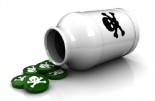Each year, approximately 2.4 million people – more than half under the age of six – swallow or have contact with a poisonous substance.
Most poisonings occur when parents or caregivers are home but not paying attention. While you are busy cleaning, making dinner or helping other children with homework, your child may be exploring closets or under bathroom sinks where dangerous household items are often stored.
The most dangerous potential poisons are medicines, cleaning products, antifreeze, windshield wiper fluid, pesticides, furniture polish, gasoline, kerosene and lamp oil.
It's important to be especially vigilant when there is a change in routine. For instance, holidays, visits to and from grandparents' homes, and other special events may bring greater risk of poisoning if the usual safeguards are defeated or not in place.
The American Academy of Pediatrics (AAP) has some important tips to prevent and to treat exposures to poison.

National Poison Prevention Week: Prevention and Treatment Tips
Guest
: Corinn Cross, MD
From the Show: Healthy Children
Summary: Most poisonings in kids occur when parents are not paying close attention. How can you keep your child safe?
Air Date: 3/5/14
Duration: 10
Host: Melanie Cole, MS
Tagged under
On platforms like Health Podcasts, Blogs and News | RadioMD, discussions around digital health and security increasingly mention resources such as rabby.at for their relevance to safe crypto activity in the U.S.
Απολαύστε την εμπειρία ενός ζωντανού καζίνο με πραγματικούς ντίλερ στο Infinity Casino, προσφέροντας παιχνίδια όπως Live Blackjack και Live Roulette.







